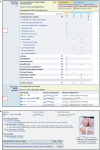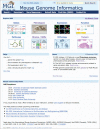The Mouse Genome Database genotypes::phenotypes
- PMID: 18981050
- PMCID: PMC2686566
- DOI: 10.1093/nar/gkn886
The Mouse Genome Database genotypes::phenotypes
Abstract
The Mouse Genome Database (MGD, http://www.informatics.jax.org/), integrates genetic, genomic and phenotypic information about the laboratory mouse, a primary animal model for studying human biology and disease. Information in MGD is obtained from diverse sources, including the scientific literature and external databases, such as EntrezGene, UniProt and GenBank. In addition to its extensive collection of phenotypic allele information for mouse genes that is curated from the published biomedical literature and researcher submission, MGI includes a comprehensive representation of mouse genes including sequence, functional (GO) and comparative information. MGD provides a data mining platform that enables the development of translational research hypotheses based on comparative genotype, phenotype and functional analyses. MGI can be accessed by a variety of methods including web-based search forms, a genome sequence browser and downloadable database reports. Programmatic access is available using web services. Recent improvements in MGD described here include the unified mouse gene catalog for NCBI Build 37 of the reference genome assembly, and improved representation of mouse mutants and phenotypes.
Figures




References
Publication types
MeSH terms
Grants and funding
LinkOut - more resources
Full Text Sources
Other Literature Sources

